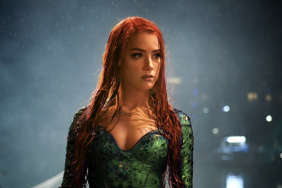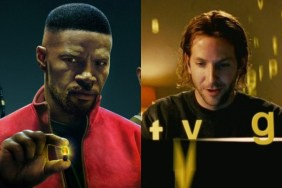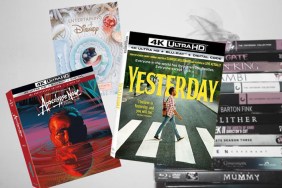Some things I need to mention right away. First: Yes, I’m afraid Boy is still in these movies. Boy, if you’ll recall from last week’s installation of The Series Project, was the curly-headed little twerp that Tarzan and Jane ended up raising in the jungle. I believe I likened Boy to Spritle Racer, who is in the running for one of the most annoying animated characters of all time (although he still runs behind Scrappy Doo). Boy is just whiny little kid who – proving my suspicions – was going to spend the bulk of his screen time in peril, only giving Tarzan an excuse to rescue him. I hate this kid. I hate him. He’s the worst kind of Hollywood moppet, and may have been the forebear of characters like Anakin Skywalker.
Another thing: Tarzan fights Nazis. Like for seriously. It won’t be until the seventh film, but Tarzan is going to be wailing on the Third Reich. Who are, perhaps not incidentally, trying to take over a lost Atlantian-type city in the wilds of Africa. Yes, dear readers, the Tarzan movies are going to, this week, fly headlong and shamelessly into batsh*t territory.

And thank goodness. If you’ll also recall from last week’s description of Tarzan Escapes, I was shocked and bored (yes, both of those things) by the appearance of Tarzan’s Swiss Family Robinson-style tree house, complete with a kitchen, an elevator, and an ape-powered ceiling fan. The entire series seemed to have taken a hard left away from the cool, strong, somewhat naughty, and kinda badassery of the first two, and veered shockingly into bland Lassie-style Saturday Morning dullness with the third. Well this week, we’ll be looking at the fifth through the eighth of the Tarzan movies featuring Johnny Weissmuller, and we’ll find that after the sixth film, a new studio will take over, and an entirely new flavor will be attempted. And while the new flavor is bugnuts, weird, and largely stupid, I appreciate it over the dullness of the old era.
When we last left Tarzan, he had found a son in Tarzan Finds a Son! Tarzan (Johnny Weissmuller) was living in jungle-bound domestic bliss with Jane (Maureen O’Sullivan). Jane was still the boss of the household, and was still an interesting person. Sadly, we had Boy (Johnny Sheffield) to contend with. And an increase of Cheeta’s chimp antics. We were firmly ensconced in the Code Era, so there wasn’t so much violence, and certainly no sex. Let’s see where we are with…
Tarzan’s Secret Treasure in His Pants (dir. Richard Thorpe, 1941)

So Tarzan, Jane, Boy, and Cheeta are living in bliss in their hidden escarpment somewhere in The Congo (and I think it was this film that finally clarified which country this is supposed to be). I know, sadly, little about The Congo, so I can’t attest to the film’s accuracy. I only sense the usual simplified Saturday Morning cartoon vibe that I got from the last two movies. I also recognized that it was shot on a set.
I do like the animal action in these movies. True, it’s clearly a lot of stock footage and rear projection, with actors on the foreground seemingly changing sizes as animals approach, but they did use real animals for many of the shots (the alligators that get stabbed look a bit more like the submarine that James Bond used on Octopussy), and Cheeta was a real well-trained chimp. And how does one get elephants to limp? I certainly hope no one hobbled elephants to make Tarzan’s Secret Treasure in His Pants.

Sorry. There’s not “In His Pants” in the real title. I’ll be good. The title is just Tarzan’s Secret Treasure.
And what is that treasure? Well, it turns out that Tarzan’s remote area of the jungle is just lousy with valuable gems, gold, and other goodies that British people like to steal. And, wouldn’t you know it, a group of Brits find their way to Tarzan’s area and attempt to do just that. Well, the whites in question this time are part of a photographic expedition, and are run by a guy named Vandermeer (Philip Dorn), another rakish type with a little mustache, which seem to be standard issue in films like this. We are also treated to a “funny” drunk Irish stereotype named O’Doul (Barry Fitzgerald, looking every bit like Smee from Disney’s Peter Pan), and there will be more than one scene of O’Doul drinking a bunch and falling down.

Tarzan is, of course, suspicious of the white guys, who have started to conspire with Boy as to where they can find the gold and gems. Jane has told Boy that back in Civilization, money can buy anything. There is a simple anti-capitalist message to these films, as they posit Tarzan’s simple money-free life is a paradise when compared to, well, anything else. It won’t take must cognitive power to predict that the white people will end up doing horrible things to get their greasy white mitts on that secret treasure. Indeed, when O’Doul comes down with the plague (!), Tarzan has to venture to a faraway land for the homeopathic (and 100% reliable) cure. Boy also catches the plague, and even though Tarzan feeds him the medicine as well, Jane, out of concern, sends Tarzan to fetch some proper English medicine as well. When he’s gone, Vandermeer kidnaps Boy and Jane, and uses them as incentive for Tarzan to reveal the treasure. No one thinks to just, y’know, ask Tarzan.

What else? Oh yeah, there’s a little black boy in this film named Tumbo (Cordell Hickman), and he and Boy play a bit. It’s a Disney version of race relations, even though this movie was put out by MGM. I guess that detail is notable in some way. Oh yes, and this is cool: A goony bird has a cameo in this film. The goony bird is actually an actor in a suit. The actor is none other than Johnny Eck, the half-man who featured heavily in Tod Browning’s Freaks. Eck was born with no legs and only half a ribcage, forcing him to walk on his hands. Seeing him dressed up in a bird suit, walking on his hands, is a truly bizarre sight.
Eventually, Tarzan is stranded down a hole, but escapes. This happens a lot in these Tarzan movies. Someone tries to kill Tarzan by luring him down a pit, where he becomes trapped. Tarzan will then use his trademark yell to summon Cheeta and a bunch of elephants, and he will free himself.

Johnny Weissmuller was, if you recall, a gold-medal-winning swimmer, so each of these films will have at least one scene of Tarzan swimming. In Tarzan’s Secret Treasure, the swimming is most spectacular, as Tarzan chases a bunch of canoes, tips them over, and feeds their contents to alligators. Tarzan only kills animals when someone is in peril. He never kills people. Never. Well, hardly ever. Stay tuned.
I can’t say much else about Tarzan’s Secret Treasure. It’s not as bad as Tarzan Escapes, but it’s hardly noticeable. The next film in the series will be the last to feature Maureen O’Sullivan, and will call some important things into question. Tarzan takes a bit outta the big apple in…
Tarzan’s New York Adventure (dir. Richard Thorpe, 1942)

Johnny Weissmuller is looking increasingly rough around the edges. Make no mistake, the guy’s still got his hot swimmer’s bod, and the dude’s got lats that make me feel gay, but you can see his age on his face at this point. Weissmuller is pushing 40 at this point, and you can tell. Good on him for staying in such good shape. Indeed, Tarzan’s New York Adventure has the guy dressed in a suit, and we kinda see for the first time how big Weissmuller actually is. The guy is still tall and strapping and a considerable measure across.
This is the final of the MGM Tarzan movies, and kind of ends an era. Maureen O’Sullivan will drop out after this, and will be replaced by a series of progressing temptations for Tarzan. This is also the film that seemed to give up on the whole purity of Tarzan thing, tilting readily into Saturday Morning blandness. Huge events occur in Tarzan’s life (yes, he goes to New York), but a huge amount of the film’s wispy 71 minutes is given over to antic shots of the horrible Chim-Chim – I mean Cheeta – eating fingerfuls of cold cream and trying on lady’s clothing. I understand it was a tough job to train that chimp, but did we have to spend half of the movie with it? Tarzan is in New York. Maybe that’s a bit more momentous.

Yeah, Tarzan, still speaking pidgin English, mind you, and still (supposedly) a naïve yet noble jungle man, is seen wearing a suit in the big city. And, yes, there is no culture shock. Tarzan is in New York, you see, trying to rescue Boy from a group of circus workers who lured Boy onto a plane after Boy showed off what he could do with elephants. The head circus worker is the usual mustachioed rake, this time played by Cy Kendall. The elephants, by the way, are Indian elephants (with the small ears) in Africa. To the series’ credit, in the previous movies, they glued fake (and fake-looking) African ears onto the Indian elephants, but kinda gave up by this movie. Indian elephants is all we’s got. Take ‘em or leave ‘em. Anyway, Boy is lured on a plane ‘cause he loves planes so much. He also has access to money thanks to Tarzan’s Secret Treasure in His… I mean Tarzan’s Secret Treasure. Boy is like a bumbling trust fund baby who always needs to be bailed out by dad. Did I mention I hate that twerp?

So, yes, Jane leads Tarzan to the nearest airport miles away, they buy new clothes (they had been in their skimpy duds this whole time), and fly to New York. These sequences are so disappointing for so many reasons. Tarzan was a simple man with simple needs, who only understood the ways of the jungle, and who couldn’t speak very good English. When confronted with money, with clothes, with all of the modern world, he seems nonplussed. He doesn’t question too much, doesn’t react with shock or awe. He’s a man on a mission. He doesn’t seem too concerned with the wonders of modern life, and there’s no alienation. I’ve seen stories like this before, and when the wild man is introduced into society, we usually feel a pang for the innocence they’re about to lose. I got no such pang in Tarzan’s New York Adventure. Tarzan didn’t really seem to notice he was in a city at all. When he has to go to court, he takes his vow and tells the truth like a good gentleman. Well, then he body-slams a lawyer, but that’s just a funny moment.

There’s some talk about who legally owns Boy, but surely the phenomenon of an apeman is more interesting, right? In the third movie, a central plot point was how much Tarzan himself would be worth in the city. I guess his value has gone down, for the white people seem little moved by his presence. Boy is living as a slave in a local circus, run by Manchester (Chill Wills, a character actor who looks almost exactly like The Rev. Ivan Stang). It’ll only be a matter of time before Tarzan is removing his shirt, and climbing around on buildings like he was in District B13. That would be thrilling if we hadn’t spent the previous 20 minutes of film watching Cheeta try on dresses. Sigh.
Goodbye Jane, goodbye MGM, and goodbye sanity. Really. Throw it to the winds. The next movie will be a bracing mouthful of unicorn tears. Let’s move to…
Tarzan Triumphs (dir. Wilhelm Thiele, 1943)

Looking ahead, I should have known something was up. The 12th film in this Tarzan cycle was Tarzan and the Mermaids. If there were going to be mermaids, perhaps I should have seen Tarzan Triumphs coming. Perhaps not. It kind of blindsided me. Let me just describe the plot to you, and see if you can hold in your credulity.
So this is the first RKO Tarzan film. Jane is gone. Maureen O’Sullivan reportedly dropped out when she got pregnant. I don’t know why she didn’t return later. We still have Weissmuller and Sheffield, anyway. Why is Jane gone? Well, Jane returned to England to look after an ailing mother, and wasn’t able to leave due to the outbreak of WWII. Curse those Nazis, keeping Jane and Tarzan separate.

So it turns out that, on this remote escarpment in the darkest recesses of The Congo, is a lost Atlantis-like city of headband-wearing white people, intelligent, but unaware of the outside world. This city is called Palandria, and Tarzan, evidently, knew of this city all along. He and Boy, sad that Jane is gone, and getting her air-dropped letters occasionally (there seems to be no trouble reaching Tarzan these days) are offered a Jane surrogate in the form of Zandra (Frances Gifford), who makes eyes at Tarzan, and implores for his help in protecting Palandria from some recent invaders.

Those invaders? Nazis! Yup. Actual, swastika-waving Nazis. Nazis are in the jungle, trying to rob Palandria. The goose-stepping kind. Why are there Nazis in a Tarzan movie? Well, the war had broken out, so it was Tarzan’s turn to fight for righteousness. The word “Nazi,” by the way, is pronounced throughout the film as “Nazzy.” It’s cute. Tarzan learns about the treachery of Nazis when he rescues one of them after he’s separated from his platoon. The Nazi uses his radio to contact his buddies, but Cheeta make off with a vital part of it. Like in the last film, a lot of screen time will be devoted to Cheeta’s anticking.

Eventually Zandra convinces Tarzan that Nazis are bad, bad men who would destroy everything, and enlists Tarzan to fight in her war. It’s been firmly established that Tarzan hates guns (he breaks one every time he sees one), and that he will only kill if someone weak is in immediate danger. Tarzan undoes all his programming here, and goes AWOL psycho crazy, and kills a bunch of guys with his bare hands. Yup, the gentle jungle lord is now pummeling Nazis to death. I know this is way, way, waaaaay out of tune for the character, but, I gotta say, I kind of appreciated the weirdness of it all. Tarzan hates Nazis. Tarzan movie as American propaganda. If you’re only going to see one Tarzan… well, see Tarzan and His Mate. But this would do as a dandy second. It’ll make your eyes fall out. But in a pleasant way.
Another note: Tarzan’s trademark yell, and all the familiar animal stock footage, was lost in the shuffle to RKO. I don’t like Tarzan’s new yell. It sounds wrong.

Nazis, man. Tarzan vs. Nazis. I’m still getting over it.
The last scene in the film is Cheeta messing with the radio, and actually talking to some important Nazi generals back in the Fatherland. Well, Cheeta chitters like a chimp, and the Nazi’s think it’s speech. They mistake the chimp for the Führer. They all salute the chimp, and it giggles. Nazi’s are evil and stupid. Good thing Tarzan is on our side.
Oh, but we ain’t yet done with the crazy…
Tarzan’s Desert Mystery (dir. Wilhelm Thiele, 1943)

I think I’m gonna like these RKO-era Tarzans. ‘Cause, man, they’re just getting stranger.
So Tarzan, implored in a letter left by Jane (still not seen on camera), takes Boy across the Arabian desert in search of the cure for Jungle Fever. The Arabian desert. In Africa. And it’s full of oil sheiks and offensive Arabian stereotypes, all played by white actors in dark makeup. How delightfully offensive! Oh yeah, and get this: one of the Nazis from the last film (now played by Otto Kruger) is now kidding out in the desert, disguised as a British businessman.

Tarzan vs. the oil sheiks. And a Nazi. I honestly wouldn’t have been surprised if vampires showed up. It’s like the filmmakers decided to go for broke and take the He-Man and the Masters of the Universe approach to Tarzan. Surely you watched the old He-Man cartoon. It took place on a distant planet, which kind of resembled The Dark Ages, and was infused with swords and sorcery and an evil living skeleton, but also had robots and tanks and lasers and stuff. It was a show based on a toy, after all, so the makers would throw in whatever new toy was out there, leaving rhyme and reason well off to the side. If we wanted a half-naked Dark Ages swordsman punching robots and wolf-men, well, dammit, we were gonna get it.
Well, now we seem to want Tarzan, the vine-swimming master of elephants, well out in the desert fighting sheiks, Nazis and magic tricks, ‘cause that’s what Tarzan’s Desert Mystery is giving us. Just break off the sanity knob. We don’t need it anymore.

Oh yeah. There’s a Jane surrogate in this film too. This time we have one Connie Bryce (Nancy Kelly), a traveling stage magician who has been summoned by the local sheik. Really? She was booked from America to trek hundreds of miles into the desert? She is a flip and flirty city gal, who instantly takes to Tarzan. We are treated to a saw-a-lady-in-half gag. In the desert, next to an oasis.
Seriously, I have no idea what’s going on in this one. I’m too astonished. I can’t even concentrate anymore. Does anyone care what happens in the plot? ‘Cause it seem unimportant. There was some intrigue with the Nazi, and the lady… a bride… kidnapped… Tarzan beats people up… Tarzan is in the desert. Nazis. That’s like having a Godzilla movie where the monster applies for a job in an office building. Or if James Bond were to suddenly fight vampires. Or if Indiana Jones were to stumble upon space aliens. Oh wait…
I have a great deal of hope for the future of this series. Next week, and the final in The Series Project: Tarzan, our shirtless hero will be talking with Amazons, a Leopard Woman, and some mermaids. The series started strong, dipped into dull Lassie territory, and is now unhinged and exciting and stupid and fun. I can only get better from here, my lovelies, so be sure to come back.






